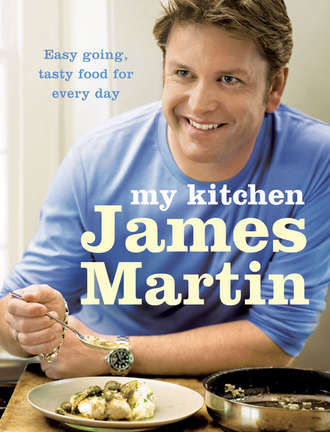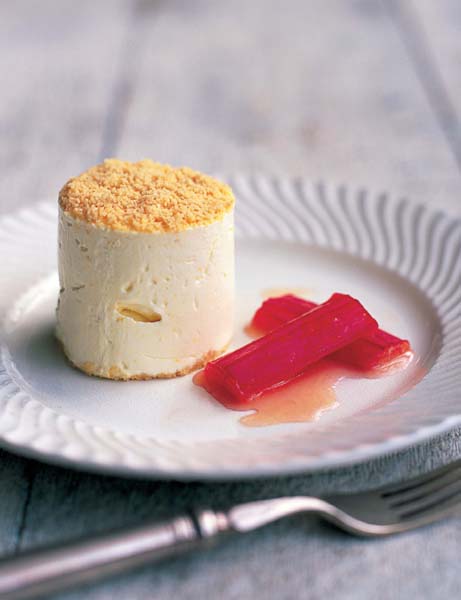
Полная версия
My Kitchen
Juniper-pickled cucumbers
Makes 400g (14oz)
Vegetarian
250ml (9fl oz) pickling malt vinegar
1 tsp juniper berries
125g (4½oz) caster sugar
1 tbsp olive oil
1 tbsp mustard seeds
2 large cucumbers, deseeded and cut into 2cm (¾in) cubes
Salt and black pepper
This will keep for 3–4 days in the fridge if stored in sealed, sterilised jars (see page 166). The pickle can be seen in the picture on page 47.
Place the vinegar, juniper berries and sugar in a small saucepan and bring to the boil. Remove from the heat. Pour the olive oil into a frying pan set over a medium–high heat, add the mustard seeds and cook until the seeds start to pop.
Add the cucumber and fry for 2–3 minutes. Season, to taste, with salt and pepper. Place in a bowl, pour over the vinegar mixture and stir well. Allow to cool completely, then place in the fridge.

Sliced Yorkshire ham with poached leeks and spring onions
Serves 4
6 black peppercorns
Pinch of salt
1 bay leaf
1 medium leek, trimmed and outer leaves removed
8 spring onions
400g (14oz) York or any other roast ham, ready-sliced if you prefer
Chervil leaves, to garnish
For the glaze
4 tbsp English mustard
2 tbsp runny honey
150ml (6fl oz) rapeseed or extra-virgin olive oil
Zest of 2 oranges
4 tbsp white wine vinegar
Salt and black pepper
Until recently, one of the few places you could buy a real ‘York ham’ was Scott’s butchers in York, but sadly, after 150 years of trading, it is now closed. Despite this, the UK still produces the best pork in the world and we should make the most of it. This recipe is best served warm; however, if you choose to serve it cold, make just half the quantity of the glaze to drizzle over the ham in the final step.
Half fill a large saucepan with water, add the peppercorns, salt and bay leaf and bring to the boil. Once the water is boiling, add the leek whole (if it doesn’t fit, cut in half widthways). Reduce the heat and cook for 6–8 minutes on a gentle simmer. Add the spring onions and cook for a further 3 minutes, then drain the vegetables and allow to cool.
To make the glaze, place the mustard and honey in a bowl, slowly whisk in the rapeseed or olive oil, then add the orange zest and vinegar, season with salt and pepper and set aside.
If you wish to warm the meat, place the whole ham or the slices on a baking tray and spoon half of the glaze over the top. Put in a preheated oven at 170°C (325°F), Gas 3, for 1 hour if the ham is whole or, if it is ready-sliced, until heated through. Remove from the oven and, if necessary, carve the ham into slices.
Place the sliced ham on a board or platter, then slice the leek into 1cm (½in) rounds and the spring onion into bite-sized lengths. Arrange these on the ham, drizzle with the rest of the glaze, place a few chervil leaves on top and serve.


Scotch eggs with curried salad cream
Serves 4
8 small eggs and 4 medium eggs (reserve 2 for the salad cream)
450g (1lb) good-quality pork sausages or sausagemeat
300g (11oz) dried breadcrumbs, such as Japanese panko
1.2 litres (2 pints) vegetable oil, for deep-frying
For the salad cream
2 hard-boiled egg yolks (see above)
2 tsp English mustard
150ml (5fl oz) rapeseed oil or extra-virgin olive oil
1 tbsp white wine vinegar
75 ml (3fl oz) double cream
1 tbsp mild curry powder, or to taste
Salt and black pepper
We’re all kids at heart, so who wouldn’t love these delicious eggs? The curried salad cream adds a nice spicy touch and will keep for two days in the fridge, although it’s best used fresh.
Fill a large saucepan with water and bring to the boil. Place the eight small eggs and two of the medium eggs in the boiling water. Remove the eight small eggs after 2–3 minutes and the two medium eggs after 7–8 minutes. Run under cold water immediately to stop them cooking any further, then peel them whole, and set the two medium ones aside.
Remove the skin from the sausages (if using), then dip your hands in cold water and divide the meat into eight balls. With wet hands, press the centre of each ball to make a well. Place a small cooked egg in each well and carefully close the meat around it. Place them on a large plate in the fridge and leave for about 2 hours to firm up.
Place the two uncooked eggs in a shallow bowl and whisk with a fork. Pour the breadcrumbs onto a plate. Dip each Scotch egg in the whisked egg, then roll in the crumbs and return to the fridge for 30 minutes. Repeat the process until each egg has a double layer of crumbs.
Meanwhile, make the salad cream. Push the yolks from the two hard-boiled medium eggs through a sieve into a bowl, then beat in the mustard, season with salt and pepper and place in a blender or food processor. Alternatively, use a hand-held beater for whisking the ingredients together.
Continued overleaf…

Whisk in the rapeseed or olive oil while the machine is on, pouring in a few drops at a time. When smoothly amalgamated, whisk in the vinegar, again a little at a time, and then slowly add the cream. Add the curry powder and season with more salt and pepper, to taste, if needed.
If using a deep-fat fryer, heat the vegetable oil to 150°C (300°F) – not too hot or the eggs will explode and the meat will not cook through. Alternatively, fill a deep, heavy-based frying pan to a depth of 2cm (¾in) with oil and use a sugar thermometer to check that it has reached the correct temperature. Carefully lower the Scotch eggs into the oil and cook for 5–7 minutes.
When cooked, serve hot or cold, with salad cream on the side.

Pressed ham terrine
Serves 4
1.5kg (3lb 4oz) ham hocks
1 onion, peeled and roughly chopped
½ tsp black peppercorns
1 tsp salt
2 sprigs of rosemary
2 bay leaves
3 leaves of gelatine
6 tbsp chopped flat-leaf parsley
Extra salt and black pepper
Crusty bread, to serve
From the base of a pig’s leg bone, a ham hock is an inexpensive cut of meat that is often overlooked. There isn’t loads of meat on it, so you’ll need several for this recipe. Serve with cucumber pickle (see page 37) and a pile of crusty bread or warm boiled potatoes.
Place the ham hocks in a large, deep saucepan, along with the onion, peppercorns, salt, rosemary and bay leaves. Cover with water and bring to the boil, then reduce the heat and simmer for 2 hours. Remove from the heat and allow to cool in the pan.
Take the hocks from the pan and set aside. Strain the cooking liquid through a fine sieve and pour 250ml (9fl oz) of it into a saucepan set over a medium heat. Place the gelatine leaves in a bowl of cold water and soak for 5 minutes until pliable, then drain the water off and add the gelatine to the hot liquid. Stir well and allow to cool.
Remove the ham from the bones and cut into 2.5cm (1in) pieces, tearing if needed. Mix with the parsley and season lightly with salt and pepper. Line a glass bowl or terrine dish about 1.2 litres (2 pints) in size with a large piece of cling film and spread a quarter of the ham pieces over the base.
Spoon over some of the gelatine liquid, add another quarter of the ham and more gelatine, repeating for two further layers and pouring over the remaining gelatine with the final layer. Stretch cling film loosely over the top, then a layer of foil, and place in the fridge – on a plate, to catch any drips – for 2 hours with a weight or weights pressing on the top.
To serve, take the terrine from the fridge, remove the cling film and accompany with pickled cucumber and crusty bread.



Rhubarb and ginger syllabub
Serves 4
2 sticks of rhubarb (preferably forced variety), cut into lcm (½in) cubes
2.5cm (1in) piece of root ginger, peeled and chopped
4 tbsp caster sugar
50ml (2fl oz) white wine
75g (3oz) mascarpone
250ml (9fl oz) double cream
2–4 tbsp icing sugar
1 piece of crystallised ginger, finely chopped
I wouldn’t be allowed back over the Yorkshire border if I didn’t put some rhubarb recipes in this book. Yorkshire is famous for parkin and puddings, but above all else, it’s celebrated for its rhubarb. The famous ‘rhubarb triangle’ is an area of land between Leeds, Wakefield and Bradford. This is where most of Britain’s forced rhubarb comes from.
Place the rhubarb, root ginger and sugar in a medium-sized saucepan and add the white wine. Set over a low–medium heat and bring to a simmer, not allowing it to boil. Cook for 4–5 minutes, or until the rhubarb is softened, then remove from the heat and set aside.
When the mixture has cooled, remove 2 tablespoonfuls to a separate bowl and mash with a fork. In another bowl, whip the mascarpone and cream together with the icing sugar and when the mixture forms soft peaks, fold in the mashed rhubarb and ginger mixture.
Spoon the rest of the poached rhubarb into bowls or glasses, then spoon over the mascarpone mixture and sprinkle the crystallised ginger over the top.

Orange cheesecake with roasted rhubarb
Serves 4
450g (1lb) full fat cream cheese
Zest and juice of 4 oranges (zest and juice kept separate)
250g (9oz) caster sugar
400ml (14fl oz) double cream
250g (9oz) crème fraîche
200g (7oz) forced rhubarb, or tender pink stems from the garden, cut into 5cm (2in) lengths
50g (2oz) butter, cut into cubes
4 shortbread biscuits
I’ve tried many cheesecake recipes over the years, but this is my favourite. It can be made with different flavours, too, such as vanilla, chocolate, strawberry or raspberry. The cakes look best when made in professional chef’s rings, which can be bought from a good cookshop or over the internet.
To make the cheesecake filling, place the cream cheese in a bowl and combine with the orange zest and 200g (7oz) of the sugar, then in another bowl whip up the double cream until it forms soft peaks.
Carefully fold together the whipped cream, the cream cheese mixture and the crème fraîche – don’t over-mix or the mixture will split. Then spoon into 6cm (2½in) chef’s rings and place on a baking tray in the fridge for 2 hours to firm up.
Preheat the oven to 240°C (475F), Gas 9. Put the rhubarb in an ovenproof dish, cover with the remaining sugar, the butter and the orange juice, and place in the oven for 8–10 minutes. Cooking in a very hot oven should cause the juice to turn to a nice syrup, but don’t overcook as rhubarb turns to mush very quickly. Check to see if it is cooked by squeezing one of the pieces, then remove and allow to cool to room temperature.
To serve, crush the shortbread to fine crumbs and remove the cheesecakes from the fridge. Roll the top and bottom of each cake in the biscuit crumbs and place on a plate. Then, using either a warm tea towel or a cook’s blowtorch, warm the rings slightly and they should just lift off. Serve with the rhubarb on the side and drizzle with some of the juices from the dish.

Crème caramel with strawberries
Serves 4–6
150ml (5fl oz) milk
300ml (11fl oz) double cream
1 vanilla pod, cut in half
4 large eggs
40g (1½oz) caster sugar
400g (14oz) fresh strawberries, hulled
For the caramel
110g (4oz) caster sugar
2 tbsp hot water
Every nation has its own version of crème caramel, using different types of milk and cream. It keeps well in the fridge, so can be made well ahead of time. Although strawberries are recognised as a summer fruit, they do start coming into season at the very end of spring. If you’re making this dessert any earlier in the year, however, you could substitute with poached forced rhubarb.
First make the caramel. Put the sugar in a medium-sized saucepan set over a medium heat. When the sugar begins to melt and darken, stir from time to time and continue to cook until it becomes a uniform syrup and a deep caramel colour.
Take the pan off the heat and carefully add the 2 tablespoons of hot water – it will spit quite a bit at first but will soon settle. Stir for 3–4 minutes and once the water is combined, quickly pour into the bottom of 4–6 × 250ml (9fl oz) ramekins, tipping it around to coat the sides of each dish.
Preheat the oven to 150°C (300°F), Gas 2. Pour the milk and cream into another saucepan, along with the vanilla pod and scraped-out seeds. Set the pan over a low heat and allow the milk and cream to heat up gently while you whisk together the eggs and sugar in a large bowl.
When the milk and cream are steaming hot, but not boiling, pour onto the egg and sugar mixture, whisking well. Pass though a sieve, then pour the liquid into the ramekins and place them in a large roasting tin. Transfer the tin carefully to the oven, then pour enough hot water into the base of the tin to surround the ramekins up to two-thirds in depth. Bake for 1 hour.
Конец ознакомительного фрагмента.
Текст предоставлен ООО «ЛитРес».
Прочитайте эту книгу целиком, купив полную легальную версию на ЛитРес.
Безопасно оплатить книгу можно банковской картой Visa, MasterCard, Maestro, со счета мобильного телефона, с платежного терминала, в салоне МТС или Связной, через PayPal, WebMoney, Яндекс.Деньги, QIWI Кошелек, бонусными картами или другим удобным Вам способом.








